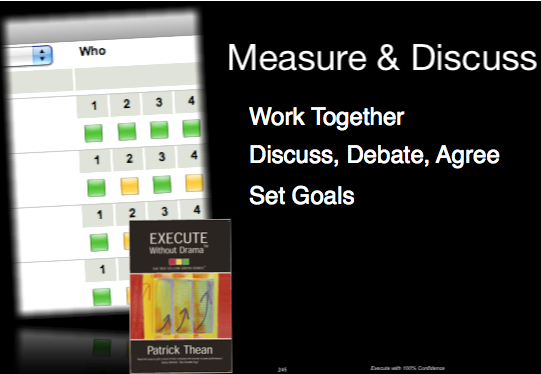Many times, the Key Performance Indicators we review at the executive team level are actually the sum or average of several smaller KPIs. Viewing KPIs in this composite form is a powerful tool that one of my clients has recently employed. What they have discovered is that it is changing the conversation at their weekly meeting and making it possible to identify bright spots more effectively. Once they have a bright spot, it is easier to scale what is working across their 20 store locations. Composite KPIs have been a minor adjustment for them that resulted in a major positive shift in their ability to adjust.
This particular client has 20 retail locations managed by 5 regional directors. Each regional director serves on the executive team and also leads the management teams for the 4 stores in their region. Below are some best practices this team has employed to drive alignment to the company goal down to the front line:
- First, the executive team worked together to determine a list of 6-8 KPIs that they want to see from each store. They standardized the set of KPIs, so every store was tracking the same ones.
- Next, they standardized the Red Yellow Green criteria for those KPIs. They determined the methodology they would use to measure each KPI as well as the measurement. For example, if the KPI was a sales goal, everyone needed to be measuring in dollars or units - pick only one. They used the process of discuss, debate, agree to determine their standard measurement for each KPI.
- Finally, they set goals starting at the top. They set an overall Company-level sales goal, measured in number of units. Then, they set the sales goals for each region. Finally, they set sales goals for each of the 20 stores.
With goals aligned from the top down, the next step was to make the goals visible in a way that would provide a framework for meaningful weekly meeting discussion. Prior to arranging the KPIs as a composite, they were arranged by store. They would look at each store individually at the weekly meeting, review each different KPI for that store, and frame the discussion around the store. With the composite KPI, the conversation changed in that they discussed each KPI from the top down individually, understanding first how they are performing as a company, then drilling down into individual region and store performance as needed. And, with Rhythm, they have a nice visual to support that conversation.
For example, at the Executive Team weekly meeting, they review the overall Company-level sales goal and then expand their view to see all the Regional sales goals in a list. This list view makes it easy to identify regions that are bright spots (SuperGreens) and regions that need adjustments (Yellows and Reds). The conversation is now about what positive things they can scale across regions.
In that same example, when the regional directors have their weekly meetings with their stores, they can do the same thing. They look at the regional sales goal, then expand their view to see all the included store sales goals in list format. Bright Spots and adjustment opportunities are obvious right off the bat and the discussion is much more meaningful and efficient.
So often in weekly meetings, clients focus only on Yellow and Reds and don't give SuperGreens their due. There is wisdom in the SuperGreens! Stop and ask the owner of the SuperGreen what worked. There might be some nuggets of wisdom there you can use across the entire organization. Something that might seem small and inconsequential to the person with the SuperGreen priority could actually be the one thing that propels someone else. Maximize those SuperGreen moments at your Weekly Meetings!
Photo Credit: iStock by Getty Images



 LinkedIn
LinkedIn
 Facebook
Facebook